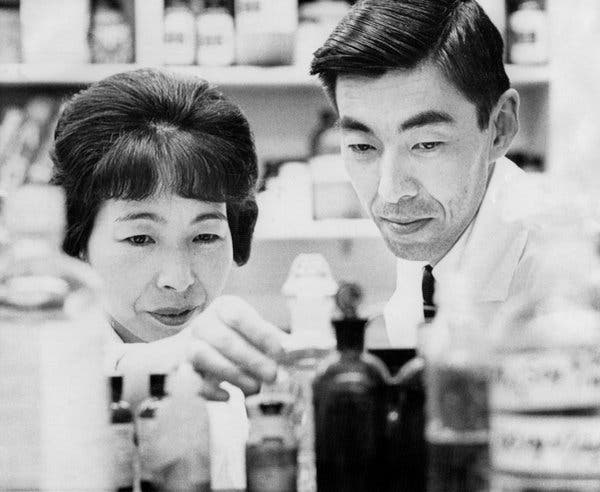Dr. Teruko Ishizaka, an immunologist whose joint research with her husband in the 1960s advanced the monitoring, treatment and prevention of asthma, hay fever and drug and food allergies, died on June 4 in Yamagata, Japan. She was 92.
Her death was announced by the La Jolla Institute for Immunology in San Diego, where she had been head of the allergy division. Her husband, Dr. Kimishige Ishizaka, had been the institute’s scientific director and president. He died last July, also at 92. They had retired to their native Japan in 1996.
Together they discovered a novel class of antibodies that trigger wheezing, itching, rashes and various allergic reactions.
“In a career span of 60 years, Ishizakas have a cumulative total of 119 publications,” the International Medical Journal reported in 2015. “This is quite a record, for a husband-wife team.”

Dr. Ishizaka and her husband, Dr. Kimishige Ishizaka, in 1967. They worked as a team for much of their careers.CreditAssociated Press
The couple joined the newly formed La Jolla Institute in 1989.
“Terry, as we called her, not only distinguished herself scientifically,” said Amnon Altman, who was recruited by the couple in 1990 and is now the head of the institute’s cell biology division, “but set a shining example in inspiring young scientists to work in a truly collaborative spirit.”
Teruko Matsuura was born on Sept. 28, 1926, in Yamagata, about 220 miles north of Tokyo, to Matsujiro and Toshi Matsuura. Her father was a lawyer; her mother was a homemaker who encouraged her daughter to pursue a professional career, an unusual path for women at the time.
In 1949, the same year she married, she graduated with a medical degree from Tokyo Women’s Medical University. She earned a doctorate in medical science from the University of Tokyo and continued her studies at the California Institute of Technology in Pasadena.
The couple conducted their defining research at the Children’s Asthma Research Institute and Hospital (now National Jewish Health) in Denver, which they joined in 1962. Their research team, analyzing the serum of hay fever sufferers exposed to ragweed, identified and isolated a rare antibody, or blood protein, that attacks foreign substances entering the body. They deciphered how the antibody, immunoglobulin E, or IgE, worked.
IgE antibodies normally attach themselves to a white blood mast cell, which secretes histamine to cause sneezing, which then expels the pollen or other offending allergen. In a person suffering from allergies, though, excessive IgE stimulates a disproportionate release of histamine.

Notable Deaths 2019: Science and Technology
A memorial to those who lost their lives in 2019
The team published its findings in 1966. Another team, headed by S.G.O Johansson and Hans Bennich in Uppsala, Sweden, published similar findings in 1969.
In “History of Allergy” (2014), Karl-Christian Bergmann wrote that the research had been groundbreaking because it enabled doctors to diagnose allergies by measuring the amount of IgE in an individual’s blood.
The Ishizakas conducted research at Johns Hopkins University in Baltimore from 1970 to 1989 before joining the La Jolla Institute.
Dr. Teruko Ishizaka was the first female scientist in Japan to receive the Behring Kitasato Prize, in 1990, for her “study of mast cells and elucidating the mechanism of allergy.” (The award is named after the Nobel Prize winner Emil Adolf von Behring and the Japanese physician and bacteriologist Shibasaburo Kitasato, who together laid the foundation for serum therapy.)
She and her husband together won numerous other professional awards.
She retired in 1993, and they returned to Japan three years later, after her husband had retired.
Survivors include her son, Yutaka Ishizaka, of Weston, Mass.

